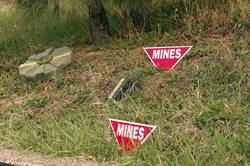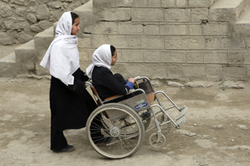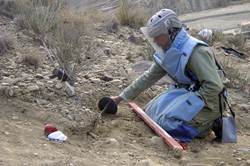


What's a landmine?
A landmine is an explosive device activated by a person or a vehicle, or command-detonated by electric wire or radio signal. Most landmines are laid on or below the surface of the ground. Normally manufactured from durable materials such as plastic, bakelite, concrete, glass or metal, landmines are designed to survive the effects of weather, seasons and time. The purpose of landmines is to disable, immobilize vehicles or kill people.
How many types of landmines are there?
There are two main categories of landmines: antipersonnel and antivehicle. The former are designed to explode when as little as two kilograms of pressure is applied-or when a person steps on them or disturbs them. The latter are designed to explode when at least 200 kilograms of pressure is applied-or when a car, jeep, truck or tank drives over them. Within each of these categories, there are many subcategories. For example, a "fragmentation mine" is a type of antipersonnel mine that sprays metal fragments through the air when it explodes. A "blast" mine is another antipersonnel mine that kills or injures a person with the sheer force of the explosion.
What's unexploded ordnance?
Unexploded ordnance, or "UXO," refers to explosive devices, such as grenades, missiles, mortars of cluster munitions that have been fired or launched but that failed to detonate on impact. They nevertheless remain volatile and capable of exploding when they are touched or disturbed.
What are explosive remnants of war?
This is a broad term that refers to unexploded ordnance and "abandoned ordnance," or unused ammunition that is left behind when armed forces leave an area.
What is mine action?
Mine action refers to the full spectrum of actions to eliminate the threat of landmines and explosive remnants of war. It includes the removal of these devices (and marking and fencing off dangerous areas), assistance to victims, mine-risk education, the destruction of stockpiled landmines, and advocating for participation in international treaties.
Source: Landmine Action Smart Book, James Madison University Mine Action Information Center, US Department of State; UNMAS and UNDP
E-MINE - Electronic Mine Information Network
UNMAS 101 - United Nations Mine Action Service (UNMAS) video